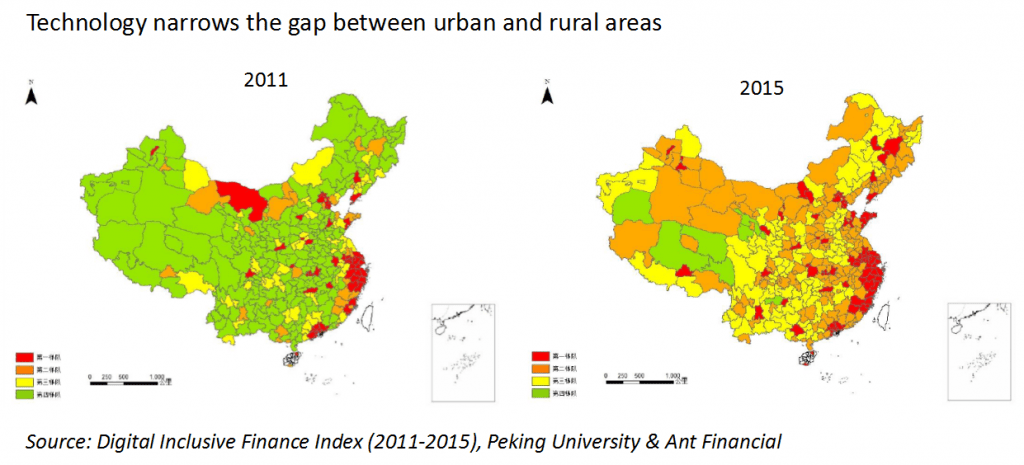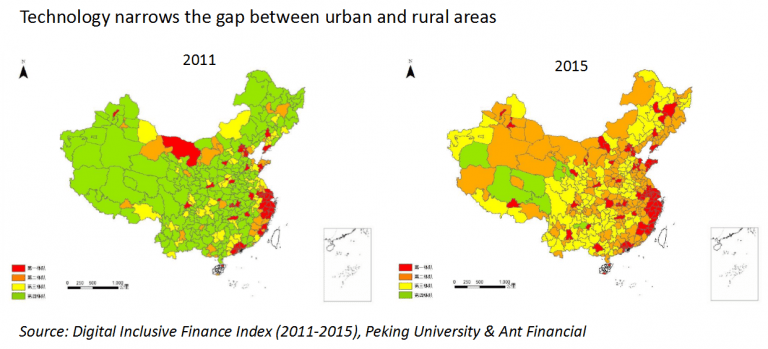[Editor’s Note: This is a post from Sherry Zhang who is the latest member of the Lend Academy and LendIt teams. Sherry is based in China and previously covered the Chinese fintech market. She is helping us craft our LangDi Fintech agenda but you will also see her contribute here on Lend Academy to give us additional insight into the Chinese market.]
A brief history of financial inclusion in China
In June 2012, then Chairman Hu Jintao mentioned financial inclusion at G20 summit in Mexico. This was the first time a top Chinese leader mentioned “financial inclusion” in a public speech.
In Nov 2013, the Party’s central committee approved an important document entitled “Decision of the Central Committee of the Communist Party of China on Some Major Issues Concerning Comprehensively Deepening the Reform”. The document made it clear that China “will develop inclusive finance.”
In Jan 2015, CBRC established a financial inclusion department under the committee to oversee micro-finance, micro-loans, P2P lending, and issues of agriculture, farmer and rural area.
In Jan 2016, the State Council issued a circular and made a five-year plan (the Plan) to develop the country’s inclusive finance. The goal of the Plan is to set an inclusive finance system that is in coordination with the construction of a moderately prosperous society by 2020 and satisfies people’s need for financial services.
This research will focus on three case studies in the financial inclusion market: CFPA MicroFinance, Ant Financial, and CreditEase.
Case study 1: CFPA MicroFinance
CFPA Microfinance is one of China’s largest microfinance players:
- As of Dec 2016, CFPA Microfinance currently has branches in 229 counties and 18 provinces throughout China, and 85% of the branches are located in areas designated by the Central or Local Governments as poverty stricken counties.
- As of Nov 2016, CFPA Microfinance has disbursed loans valued at RMB CNY 18.4 billion ($2.7 billion) to 1.61 million clients, with average loan size of CNY 11,000 ($1,620). 62% of all loans have been deployed for the purpose of raising livestock, breeding fish and farming and etc.
- Approximately 3 million low-income villagers have received microloans from CFPA Microfinance for improving their livelihood and raising local production.
CFPA Microfinance’s largest shareholder, China Foundation for Poverty Alleviation (CFPA), was established in 1989. CFPA was one of the first non-profit organizations in China. International Finance Corporation (IFC) became acquainted with the foundation in 2007, and suggested that it make its microfinance business an independent business.
In November 2008, CFPA Microfinance Co. was established. In 2010, Sequoia China Capital and IFC made equity investments in CFPA Microfinance. After the investments, the CFPA’s ownership in CPFA Microfinance was reduced from 100% to 61%.
In Dec 2016, Ant Financial, IFC and High Impact Capital Advisors announced another investment in CFPA Microfinance. After that, Ant became the second-largest shareholder after CFPA.
A report by IFC (2012) said that, IFC helped CFPA Microfinance in terms of corporate governance, IT systems, HR, risk management, so CFPA Microfinance has achieved both business performance and social development:
Business performance:
- CFPA Microfinance now ranks among the top microfinance institutions in China in terms of profitability, asset quality, operating efficiency, and (low) average loan size.
Social development:
- 91% of all CFPA Microfinance clients are women
- At least 80% of CFPA Microfinance clients would not have been able to borrow from anywhere else, according to a survey by the China Agriculture University and China Academy of Social Sciences
- 49 out of the 53 CFPA Microfinance operating outlets are in China’s Nationally Designated Poverty Countries, the poorest areas in the country.
Case study 2: Ant Financial
Ant Financial has achieved so much in financial inclusion in a broad sense: Yu’e Bao, the world’s largest money market fund, makes it easy for financially illiterate people to do personal finance; Alipay is so-widely used in China, even in rural areas.
When it comes to poverty alleviation, Ant Financial chose CFPA Microfinance to partner with.
Ant Financial started getting acquainted with CFPA Microfinance in Nov 2015. They hoped to do a pilot project in Pingjiang County of Hunan Province.
Then Ant Financial President Jing Xiandong said at that time that, Ant Financial would cooperate with CFPA Microfinance in fields including risk management, capital, big data, and channel, and that Ant would provide financial services to people in rural areas.
In June 2016, Ant Financial and CFPA Microfinance reached a strategic cooperation in Pingjiang, Hunan.
With the two parties cooperation in technology and channels, it is possible that when a farmer needs to borrow money, the lending decision would be made based on big data, rather than the information collected by loan officers.
In Dec 2016, Ant Financial announced the establishment of a joint venture with China Insurance to provide loans to farmers. At the same time, Ant Financial announced its strategic investment to CFPA Microfinance.
The data from Ant Financial can reflect the change of China’s inclusive finance landscape.
Huang Yiping, a professor of economics in Peking University, did research on the digital financial inclusion gap between urban and rural area (2011-2015) based on Ant Financial’s data.
Research shows that, by the measure of “digital financial inclusion index” created by Prof. Huang Yiping, the condition of underdeveloped areas in China in 2015 are relatively better off compared with five years ago.

Case study 3: CreditEase
CreditEase’s efforts in financial inclusion to reduce poverty can be best illustrated by the example of Yinongdai. Yinongdai is a philanthropic P2P platform launched by CreditEase in 2009. It claims to be a non-profit loan program that targets low-income rural farmers.
What Yinongdai does is that it helps to match “charitable lenders” with impoverished credible rural borrowers. To be more specific, “charitable lenders” can choose a farmer’s project and “donate” at least RMB 100 ($14.70), and lenders can get roughly 2% return annually.
For over the seven years, Yinongdai has collected over 200 million RMB ($29 million) from 150,000 lenders, and helped about 20,000 needy farmers, Tang Ning said in an interview in Apr 2017.
Yinongdai is an important capital source for micro-loan NGOs, because the latter can provide sustainable, cheap money.
Yinongdai also has agreements with these NGOs that if farmers default on their loans, these institutions will pay the money back to Yinongdai – so that these institutions take obligations while enjoying the advantage of low cost of capital.


